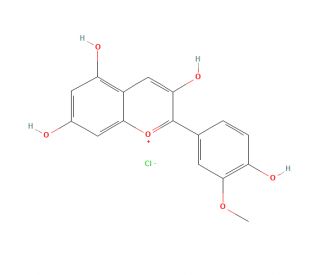

Molecular structure of Peonidin chloride, CAS Number: 134-01-0
Peonidin chloride (CAS 134-01-0)
See product citations (1)
Alternate Names:
3,4′,5,7-Tetrahydroxy-3′-methoxyflavylium chloride
Application:
Peonidin chloride is an antioxidant flavonoid
CAS Number:
134-01-0
Purity:
≥98%
Molecular Weight:
336.72
Molecular Formula:
C16H13O6Cl
For Research Use Only. Not Intended for Diagnostic or Therapeutic Use.
* Refer to Certificate of Analysis for lot specific data.
QUICK LINKS
Ordering Information
Product Citations
Description
Technical Information
Safety Information
SDS & Certificate of Analysis
Peonidin chloride is a preparation of Peonidin, a methoxy anthocyanidin compound that exhibits antiinflammatory effects. Peonidin is described to inhibit 12-O-tetradecanoylphorbol-13-acetate (TPA)-induced COX-2 expression, to decrease TPA-induced neoplastic transformation, and to block TPA-induced phosphorylation of extracellular signal-regulated kinases in JB6 P(+) cells.
Peonidin chloride (CAS 134-01-0) References
- Comparison of HPLC methods for determination of anthocyanins and anthocyanidins in bilberry extracts. | Zhang, Z., et al. 2004. J Agric Food Chem. 52: 688-91. PMID: 14969517
- Anthocyanidins inhibit cyclooxygenase-2 expression in LPS-evoked macrophages: structure-activity relationship and molecular mechanisms involved. | Hou, DX., et al. 2005. Biochem Pharmacol. 70: 417-25. PMID: 15963474
- Identification of ellagic acid conjugates and other polyphenolics in muscadine grapes by HPLC-ESI-MS. | Lee, JH., et al. 2005. J Agric Food Chem. 53: 6003-10. PMID: 16028988
- Peonidin inhibits phorbol-ester-induced COX-2 expression and transformation in JB6 P+ cells by blocking phosphorylation of ERK-1 and -2. | Kwon, JY., et al. 2007. Ann N Y Acad Sci. 1095: 513-20. PMID: 17404064
- Anthocyanidin-containing compounds occur in the periderm cell walls of the storage roots of sweet potato (Ipomoea batatas). | Philpott, M., et al. 2009. J Plant Physiol. 166: 1112-7. PMID: 19201049
- Storage elevates phenolic content and antioxidant activity but suppresses antiproliferative and pro-apoptotic properties of colored-flesh potatoes against human colon cancer cell lines. | Madiwale, GP., et al. 2011. J Agric Food Chem. 59: 8155-66. PMID: 21736387
- Surface-enhanced Raman scattering (SERS) study of anthocyanidins. | Zaffino, C., et al. 2015. Spectrochim Acta A Mol Biomol Spectrosc. 149: 41-7. PMID: 25942083
- Innovative Anthocyanin/Anthocyanidin Formulation Protects SK-N-SH Cells Against the Amyloid-β Peptide-Induced Toxicity: Relevance to Alzheimer's Disease. | Belkacemi, A. and Ramassamy, C. 2015. Cent Nerv Syst Agents Med Chem. 16: 37-49. PMID: 26238538
- Anthocyanins Protect SK-N-SH Cells Against Acrolein-Induced Toxicity by Preserving the Cellular Redox State. | Belkacemi, A. and Ramassamy, C. 2016. J Alzheimers Dis. 50: 981-98. PMID: 26890747
- Flavonoids electrochemical detection in fruit extracts and total antioxidant capacity evaluation. | Gomes, SM., et al. 2016. Talanta. 154: 284-91. PMID: 27154676
- Inheritance and QTL analysis of the determinants of flower color in tetraploid cut roses. | Gitonga, VW., et al. 2016. Mol Breed. 36: 143. PMID: 27795693
- Changes in anthocyanidin levels during the maturation of color-fleshed potato (Solanum tuberosum L.) tubers. | Šulc, M., et al. 2017. Food Chem. 237: 981-988. PMID: 28764096
- Role of Gut Microbiota in the Anti-Colitic Effects of Anthocyanin-Containing Potatoes. | Li, S., et al. 2021. Mol Nutr Food Res. 65: e2100152. PMID: 34633750
- Metabolite identification in fresh wheat grains of different colors and the influence of heat processing on metabolites via targeted and non-targeted metabolomics. | Feng, J., et al. 2022. Food Res Int. 160: 111728. PMID: 36076417
- Structure-antioxidant activity relationships of flavonoids and phenolic acids. | Rice-Evans, CA., et al. 1996. Free Radic Biol Med. 20: 933-56. PMID: 8743980
Ordering Information
| Product Name | Catalog # | UNIT | Price | Qty | FAVORITES | |
Peonidin chloride, 5 mg | sc-202762 | 5 mg | $352.00 |
